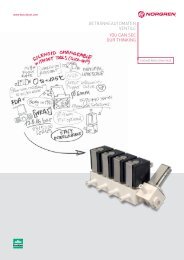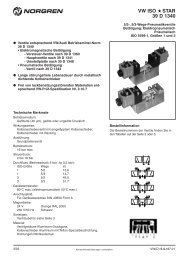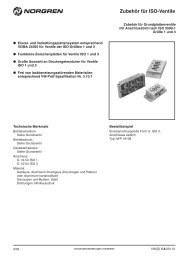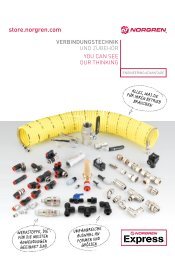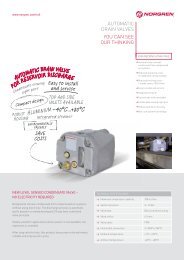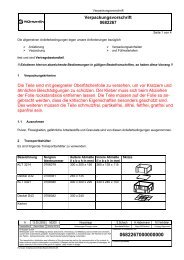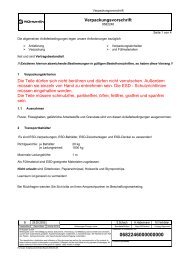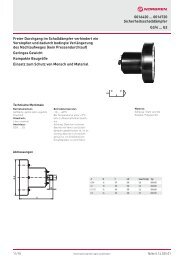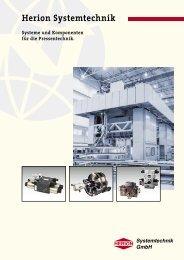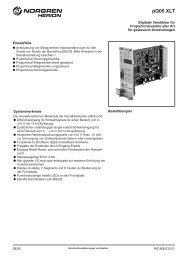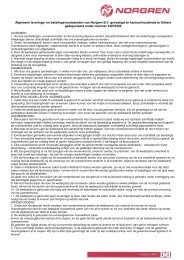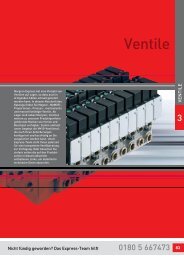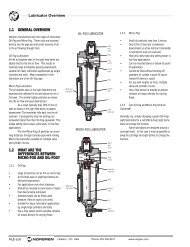Energy saving in compressed air systems - Norgren Pneumatics ...
Energy saving in compressed air systems - Norgren Pneumatics ...
Energy saving in compressed air systems - Norgren Pneumatics ...
You also want an ePaper? Increase the reach of your titles
YUMPU automatically turns print PDFs into web optimized ePapers that Google loves.
Flow to<br />
atmosphere<br />
[scfm]<br />
@ P1=100<br />
psig<br />
How to improve energy efficiency<br />
Orifice flow data<br />
can be used to<br />
approximate the<br />
flow to<br />
atmosphere<br />
through holes of<br />
different sizes.<br />
The graph (figure<br />
5) shows the<br />
relation between<br />
flow and hole<br />
diameter.<br />
The basis for calculat<strong>in</strong>g the costs of flow losses is the waste formula:<br />
Total cost = 0.19 x operat<strong>in</strong>g hours per year x flow scfm x energy cost per kWh. (0.19 is<br />
a factor relat<strong>in</strong>g kW to scfm for typical compressors).<br />
The cost of a s<strong>in</strong>gle cont<strong>in</strong>uous leak from a 0.08 <strong>in</strong> (2mm) diameter orifice with 8 scfm<br />
is:<br />
0.19 x 8400 x 8 x 0.068 = $ 868 / year<br />
The average leak will take around half a man-hour to fix and offer quick payback.<br />
Misuse of jets<br />
35<br />
30<br />
25<br />
20<br />
15<br />
10<br />
5<br />
0<br />
Flow [scfm]<br />
Diameter [<strong>in</strong>] of round orifice<br />
Figure 5: Leakage rate for different hole diameters<br />
A major waste of <strong>compressed</strong> <strong>air</strong> is lack of consideration for the detailed specification<br />
and application of equipment. Frequently with<strong>in</strong> a mach<strong>in</strong>e cycle, jets of <strong>air</strong> from nozzles<br />
are used to carry out processes such as dust<strong>in</strong>g, cool<strong>in</strong>g, separat<strong>in</strong>g and other tasks.<br />
Sometimes due to the normal high throughput of a mach<strong>in</strong>e these jets are left<br />
permanently runn<strong>in</strong>g. With most mach<strong>in</strong>es there will be times when the production<br />
process is <strong>in</strong>termittent or even at a halt. Jets that cont<strong>in</strong>ue to run <strong>in</strong> these circumstances<br />
are <strong>in</strong>curr<strong>in</strong>g unnecessary costs. With a suitable valve and sensor, these can be controlled<br />
automatically so they are only on when required.<br />
When apply<strong>in</strong>g jets ensure that the distance between the exit nozzle and the product is as<br />
short as possible, this will allow the supply pressure to be reduced. Air saver nozzles are<br />
designed to entra<strong>in</strong> and accelerate <strong>air</strong>, these produce the desired outputs with reduced<br />
supply pressures (typically 30 psig). Sav<strong>in</strong>gs of up to twenty times can result.<br />
Page 4 of 8



